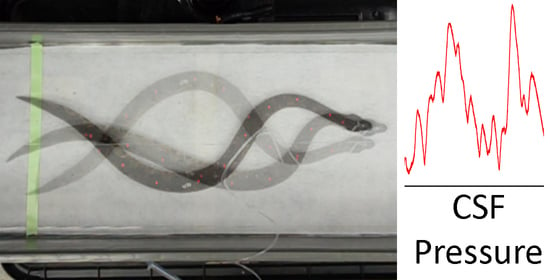Slithering CSF: Cerebrospinal Fluid Dynamics in the Stationary and Moving Viper Boa, Candoia aspera
Abstract
:Simple Summary
Abstract
1. Introduction
2. Materials and Methods
2.1. Live Animals
2.2. Cardiac and Ventilatory Influence
2.3. Orthostatic Gradients
2.4. Axial Deflection
3. Results
3.1. Heart Rate
3.2. CSF in the Immobile Snake
3.3. Manual Axial Deflection
3.4. Observations on Freely Locomoting Snakes
4. Discussion
Author Contributions
Funding
Institutional Review Board Statement
Informed Consent Statement
Data Availability Statement
Acknowledgments
Conflicts of Interest
Statement of Institutional Review
References
- Clarke, E.C.; Stoodley, M.A.; Bilston, L.E. Changes in temporal flow characteristics of CSF in Chiari malformation Type 1 with and without syringomyelia: Implications for theory of syrinx development. J. Neurosurg. 2013, 118, 1135–1140. [Google Scholar] [CrossRef]
- Buell, T.; Heiss, J.; Oldfield, E. Pathogenesis and cerebrospinal fluid hydrodynamics of the Chiari I malformation. Neurosurg. Clin. N. Am. 2015, 26, 495–499. [Google Scholar] [CrossRef] [Green Version]
- Geregele, L.; Baledent, O.; Manet, R.; Lalou, A.; Barszcz, S.; Kasprowicz, M.; Smielewski, P.; Pickard, J.D.; Czosnyka, M.; Czosnyka, Z. Dynamics of cerebrospinal fluid: From theoretical models to clinical applications. In Biomechanics of the Brain; Miller, K., Ed.; Springer Nature: Berlin/Heidelberg, Germany, 2019; pp. 181–214. [Google Scholar]
- Wagshul, M.; Eide, P.; Madsen, J. The pulsating brain: A review of experimental and clinical studies of intracranial pulsatility. Fluids Barriers CNS 2011, 8, 5. [Google Scholar] [CrossRef] [PubMed] [Green Version]
- Vinje, V.; Ringstad, G.; Lindstrom, E.; Valnes, L.; Rognes, M.; Eide, P.; Mardal, K.-A. Respiratory influence on cerebrospinal fluid flow—A computational study based on long-term intracranial pressure measurements. Sci. Rep. 2019, 9. [Google Scholar] [CrossRef]
- Young, B.A.; Adams, J.; Beary, J.M.; Mardal, K.-A.; Schneider, R.; Kondrashova, T. Variations in the cerebrospinal fluid dynamics of the American alligator (Alligator mississippiensis). Fluids Barriers CNS 2021, 18. [Google Scholar] [CrossRef] [PubMed]
- Axelsson, M.; Franklin, C.E.; Lofman, C.O.; Nilsson, S.; Grigg, G.C. Dynamic anatomical study of cardiac shunting in crocodiles using high-resolution angioscopy. J. Exp. Biol. 1996, 199, 359–365. [Google Scholar] [CrossRef] [PubMed]
- Syme, D.A.; Gamperl, K.; Jones, D. Delayed depolarization of the cog-wheel valve and pulmonary-to-systemic shunting in alligators. J. Exp. Biol. 2002, 205, 1843–1851. [Google Scholar] [CrossRef]
- Farmer, C.; Carrier, D. Pelvic aspiration in the American alligator (Alligator mississippiensis). J. Exp. Biol. 2000, 203, 1679–1687. [Google Scholar] [CrossRef]
- Klassen, M.; Adams, J.; Cramberg, M.; Knoche, L.; Young, B.A. The narial musculature of Alligator mississippiensis: Can a muscle be its own antagonist? J. Morphol. 2020. [Google Scholar] [CrossRef] [PubMed]
- Klose, U.; Strik, C.; Kiefer, C.; Grodd, W. Detection of a relation between respiration and CSF pulsation with an echoplanar technique. J. Magn. Reson. Imaging 2000, 11, 438–444. [Google Scholar] [CrossRef]
- Dreha-Kulaczewski, S.; Joseph, A.; Merboldt, K.-D.; Ludwig, H.-C.; Gartner, J.; Frahm, J. Inspiration is the major regulator of human CSF flow. J. Neurosci. 2015, 35, 2485–2491. [Google Scholar] [CrossRef]
- Yildiz, S.; Thyagaraj, S.; Jin, N.; Zhong, X.; Pahlavian, S.; Martin, B.; Loth, F.; Oshinski, J.; Sabra, K. Quantifying the influence of respiration and cardiac pulsations on cerebrospinal fluid dynamics using real-time phase-contrast MRI. J. Magn. Reson. Imaging 2017, 46, 431–439. [Google Scholar] [CrossRef]
- Bloomfield, G.; Ridlings, P.; Blocher, C.; Marmarou, A.; Sugerman, H. A proposed relationship between increased intra-abdominal, intrathoracic, and intracranial pressure. Crit. Care Med. 1997, 25, 496–503. [Google Scholar] [CrossRef] [PubMed]
- Guerci, A.; Shi, A.; Levin, H.; Tsitlik, J.; Weisfeldt, M.; Chandra, N. Transmission of intrathoracic pressure to the intracranial space during cardiopulmonary resuscitation in dogs. Circ. Res. 1985, 56, 20–30. [Google Scholar] [CrossRef] [Green Version]
- Marino, B.; Yannopoulos, D.; Sigurdsson, G.; Lai, L.; Cho, C.; Redington, A.; Nicolson, S.; Nadkarni, V.; Lurie, K. Spontaneous breathing through an inspiratory impedance threshold device augments cardiac index and stroke volume index in a pediatric porcine model of hemorrhagic hypovolemia. Crit. Care Med. 2004, 32, S398–S405. [Google Scholar] [CrossRef] [PubMed]
- Citerio, G.; Vascotto, E.; Villa, F.; Celotti, S.; Pesenti, A. Induced abdominal compartment syndrome increases intracranial pressure in neurotrauma patients: A prospective study. Crit. Care Med. 2001, 29, 1466–1471. [Google Scholar] [CrossRef] [PubMed]
- Deeren, D.; Dits, H.; Malbrain, M. Correlation between intra-abdominal and intracranial pressure in non-traumatic brain injury. Int. Care Med. 2005, 31, 1577–1581. [Google Scholar] [CrossRef] [PubMed]
- Cramberg, M.; Greer, S.; Young, B.A. The functional morphology of the post-pulmonary septum of the American alligator (Alligator mississippiensis). Anat. Rec. 2021, in press. [Google Scholar]
- Claessons, L. A cineradiographic study of lung ventilation in Alligator mississippiensis. J. Exp. Zool. A 2009, 311, 563–585. [Google Scholar] [CrossRef]
- Holmlund, P.; Eklund, A.; Kokinen, L.O.; Johansson, E.; Sundstrom, N.; Malm, J.; Qvarlander, S. Venous collapse regulates intracranial pressure in upright body posture. Am. J. Physiol. 2017. [Google Scholar] [CrossRef] [Green Version]
- Kuzman, T.; Jurjevic, I.; Mandac, I.; Rados, M.; Oreskovic, D.; Jednacak, H.; Klarica, M. The effect of body position on intraocular and CSF pressures in the lateral ventricle, and in cortical and lumbar subarachnoid spaces in cats. In Intracranial Pressure and Brain Monitoring XIV; Schuhmann, M., Czosnyka, M., Eds.; Springer: Berlin/Heidelberg, Germany, 2012. [Google Scholar] [CrossRef]
- Knoche, L.; Young, B.A.; Kondrashova, T. The influence of gravitational gradients on the American alligator (Alligator mississippiensis). Anat. Physiol. Curr. Res. 2019. [Google Scholar] [CrossRef] [Green Version]
- Kondrashova, T.; Blanchard, J.; Knoche, L.; Potter, J.; Young, B.A. Intracranial pressure in the American alligator (Alligator mississippiensis): Reptilian meninges and orthostatic gradients. J. Comp. Physiol. A 2020. [Google Scholar] [CrossRef] [PubMed]
- Thouvenin, O.; Keiser, L.; Cantaut-Belarif, Y.; Carbo-Tano, M.; Verweij, F.; Jurisch-Yaksi, N.; Bardet, P.-L.; van Niel, G.; Gallaire, F.; Wyart, C. Origin and role of the cerebrospinal fluid bidirectional flow in the central canal. eLIFE 2020, 9, e47699. [Google Scholar] [CrossRef]
- Zheng, N.; Yuan, X.-Y.; Chi, Y.-Y.; Liu, P.; Wang, B.; Sui, J.-Y.; Ho, S.-H.; Yu, S.-B.; Sui, H.-J. The universal existence of myodural bridge in mammals: An indication of a necessary function. Sci. Rep. 2017, 7, 8248. [Google Scholar] [CrossRef] [Green Version]
- Okoye, C.; Zheng, N.; Yu, S.; Sui, H. The myodural bridge in the common rock pigeon (Columbia livia): Morphology and possible physiological implications. J. Morphol. 2018, 279, 1524–1531. [Google Scholar] [CrossRef] [PubMed]
- Young, B.A.; Adams, J.; Beary, J.; Mardal, K.-A.; Schneider, R.; Kondarshova, T. The myodural bridge of the American alligator (Alligator mississippiensis) alters CSF flow. J. Exp. Biol. 2020, 223. [Google Scholar] [CrossRef]
- Olstad, E.; Ringers, C.; Hansen, J.; Wens, A.; Brandt, C.; Wachten, D.; Yaksi, E.; Jurisch-Yaksi, N. Ciliary beating compartmentalizes cerebrospinal fluid flow in the brain and regulates ventricular development. Curr. Biol. 2019, 29, 229–241. [Google Scholar] [CrossRef] [PubMed] [Green Version]
- Young, B.A.; Lillywhite, H.B.; Wassersug, R.J. On the structure of the aortic valves in snakes (Reptilia: Serpentes). J. Morphol. 1993, 216, 141–160. [Google Scholar] [CrossRef]
- Young, B.A.; Saunders, M. Direct visualization of blood flow through the interaortic foramen of the eastern diamondback rattlesnake, Crotalus adamanteus, using echocardiography and color Doppler imaging. J. Exp. Zool. 1999, 284, 742–745. [Google Scholar] [CrossRef]
- Wallach, V. The lungs of snakes. In Biology of the Reptilia; Gans, C., Gaunt, A., Eds.; Society for the Study of Amphibians and Reptiles: New York, NY, USA, 1998; Volume 19, pp. 93–295. [Google Scholar]
- Rosenberg, H. Functional anatomy of pulmonary ventilation in the garter snake, Thamnophis elegans. J. Morphol. 1973, 140, 171–184. [Google Scholar] [CrossRef]
- Milsom, W. Intermittent breathing in vertebrates. Ann. Rev. Physiol. 1991, 53, 87–105. [Google Scholar] [CrossRef] [PubMed]
- Young, B.A.; Wassersug, R.; Pinder, A. Gravitational gradients and blood flow patterns in specialized arboreal (Ahaaetulla nasuta) and terrestrial (Crotalus adamanteus) snakes. J. Exp. Zool. 1997, 167, 481–493. [Google Scholar]
- Lillywhite, H.B.; Albert, J.; Sheehy, C., III; Seymour, R. Gravity and the evolution of cardiopulmonary morphology in snakes. Comp. Biochem. Physiol. A 2012, 161, 230–242. [Google Scholar] [CrossRef] [PubMed] [Green Version]
- Leal, F.; Cohn, M. Developmental, genetic, and genomic insights into the evolutionary loss of limbs in snakes. Genesis 2018, 56. [Google Scholar] [CrossRef] [PubMed]
- Jayne, B. Kinematics of terrestrial snake locomotion. Copeia 1986, 1986, 915–927. [Google Scholar] [CrossRef]
- Morinaga, G.; Bergmann, P. Angles and waves: Intervertebral joint angles and axial kinematics of limbed lizards, limbless lizards, and snakes. Zoology 2019, 134, 16–26. [Google Scholar] [CrossRef] [PubMed]
- O’Shea, M. A Guide to the Snakes of Papua New Guinea; Independent Group: Port Moresby, New Zealand, 1996. [Google Scholar]
- Lillywhite, H.B. Orthostatic intolerance of viperid snakes. Physiol. Zool. 1993, 66, 1000–1014. [Google Scholar] [CrossRef]
- Austin, C. Molecular phylogeny and historical biogeography of the pacific island Boas (Candoia). Copeia 2000, 2000, 341–352. [Google Scholar] [CrossRef]
- Gans, C. Terrestrial locomotion without limbs. Am. Zool. 1962, 2, 167–182. [Google Scholar] [CrossRef] [Green Version]
- Jayne, B. What defines different modes of snake locomotion? Integr. Comp. Biol. 2020, 60, 156–170. [Google Scholar] [CrossRef]
- Valentinuzzi, M.; Hoff, M.; Geddes, L. Electrocardiogram of the snake: Intervals and durations. J. Electrocard. 1969, 2, 343–352. [Google Scholar] [CrossRef]
- Jacob, J.; McDonald, H. Temperature preferences and electrocardiology of Elaphe obsoleta (Serpentes). Comp. Biochem. Physiol. A 1975, 52, 591–594. [Google Scholar] [CrossRef]
- Lillyhite, H.B.; Seymour, R. Regulation of arterial blood pressure in Australian tiger snakes. J. Exp. Biol. 1978, 75, 65–79. [Google Scholar] [CrossRef]
- Armelin, V.A.; da Silva Braga, V.H.; Guagnoni, I.N.; Crestani, A.M.; Abe, A.S.; Florindo, L.H. Autonomic control of cardiovascular adjustments associated with orthostasis in the scansorial snake, Boa constrictor. J. Exp. Biol. 2019. [Google Scholar] [CrossRef] [Green Version]
- Qvarlander, S.; Sundstrom, N.; Malm, J.; Eklund, A. Postural effects on intracranial pressure: Modeling and clinical evaluation. J. Appl. Physiol. 2013, 115, 1474–1480. [Google Scholar] [CrossRef] [PubMed] [Green Version]
- Lillywhite, H.B. Circulatory adaptations of snakes to gravity. Am. Zool. 1987, 27, 81–95. [Google Scholar] [CrossRef]
- Holmlund, P.; Johansson, E.; Qvarlander, S.; Wahlin, A.; Ambarki, K.; Koskinen, L.O.D.; Malm, J.; Eklund, A. Human jugular vein collapse in the upright posture: Implications for postural intracranial pressure regulation. Fluids Barriers CNS 2017, 14. [Google Scholar] [CrossRef]
- Davson, H.; Hollingsworth, G.; Segal, M. The mechanism of drainage of the cerebrospinal fluid. Brain 1970, 93, 665–678. [Google Scholar] [CrossRef]
- Gega, A.; Utsumi, S.; Iida, Y.; Iida, N.; Tsuncda, S. Analysis of the wave pattern of CSF pulse wave. In Intracranial Pressure IV; Shulman, K., Marmarou, A., Miller, J.D., Becker, D.P., Hochwald, G.M., Brock, M., Eds.; Springer: New York, NY, USA, 1980. [Google Scholar] [CrossRef]
- Zamboni, P.; Menegatti, E.; Pomidori, L.; Morovic, S.; Taibi, A.; Malagoni, A.M.; Cogo, A.L.; Gambaccini, M. Does thoracic pump influence the cerebral venous return? J. Appl. Physiol. 2012, 112, 904–910. [Google Scholar] [CrossRef] [Green Version]
- Daouk, J.; Bouzerar, R.; Baledent, O. Heart rate and respiration influence on macroscopic blood and CSF flows. Acta Radiol. 2016. [Google Scholar] [CrossRef] [PubMed]
- Ludicke, M. Ordnung der Klasse Reptilia, Serpents. In Handbuch der Zoologie, Band 7. Halfte 1; W. de Gruyter: Berlin, Germany, 1964; pp. 1–298. [Google Scholar]
- Bustard, H.R. Defensive behavior and locomotion of the Pacific Boa, Candoia aspera, with a brief review of head concealment in snakes. Herpetologica 1969, 25, 164–170. [Google Scholar]
- Huangfu, Z.; Zhang, X.; Sui, J.-Y.; Zhao, Q.-Q.; Yuan, X.-Y.; Li, C.; Dou, Y.-R.; Tang, W.; Du, M.-L.; Zheng, N.; et al. Existence of myodural bridge in the Trachemys scripta elegans: Indication of its important physiological function. Internat. J. Morphol. 2019, 37, 1353–1360. [Google Scholar] [CrossRef]
- Chen, C.; Yu, S.-B.; Chi, Y.-Y.; Tan, G.-Y.; Yan, B.-C.; Zheng, N.; Sui, H.-J. Existence and features of the myodural bridge in Gentoo penguins: A morphological study. PLoS ONE 2021, 16, e0244774. [Google Scholar] [CrossRef]
- Filippov, A.; Westhoff, G.; Kovalev, A.; Gorb, S. Numerical model of the slithering snake locomotion based on the friction anisotropy of the ventral skin. Tribol. Lett. 2018, 66. [Google Scholar] [CrossRef]
- Gray, J. The mechanism of locomotion in snakes. J. Exp. Biol. 1946, 23, 101–120. [Google Scholar] [CrossRef]
- Babbs, C.F. A new biomechanical head injury criterion. J. Mech. Med. Biol. 2006, 6, 349–371. [Google Scholar] [CrossRef] [Green Version]
- Hentschel, S.; Mardal, K.-A.; Lovgres, A.; Linge, S.; Haughton, V. Characterization of cyclic CSF flow in the foramen magnum and upper cervical spinal canal with MR flow imaging and computational fluid dynamics. Amer. J. Neurorad. 2010, 31, 997–1002. [Google Scholar] [CrossRef] [Green Version]
- Kurtcuoglu, V.; Jain, K.; Martin, B. Modelling of cerebrospinal fluid flow by computational fluid dynamics. In Biomechanics of the Brain; Miller, K., Ed.; Springer Nature: Berlin/Heidelberg, Germany, 2019; pp. 215–242. [Google Scholar]
- Xu, Q.; Yu, S.-B.; Zheng, N.; Yuan, X.-Y.; Chi, Y.-Y.; Liu, C.; Wang, X.-M.; Lin, X.-T.; Sui, H.-J. Head movement, an important contributor to human cerebrospinal fluid circulation. Sci. Rep. 2016, 6. [Google Scholar] [CrossRef] [Green Version]
- Nelson, E.; Mulugeta, L.; Feola, A.; Raykin, J.; Myers, J.; Samuels, B.; Ethier, C. The impact of ocular hemodynamics and intracranial pressure on intraocular pressure during acute gravitational changes. J. Appl. Physiol. 2017, 123, 352–363. [Google Scholar] [CrossRef] [Green Version]
- Salerni, F.; Repetto, R.; Harris, A.; Pinsky, P.; Prudhomme, C.; Szopos, M.; Guidoboni, G. Biofluid modeling of the coupled eye-brain system and insights into simulated microgravity conditions. PLoS ONE 2019, 14, e0216012. [Google Scholar] [CrossRef] [Green Version]
- Ritter, D. Lateral bending during lizard locomotion. J. Exp. Biol. 1992, 173, 1–10. [Google Scholar] [CrossRef]
- Ashley-Ross, M.; Lundin, R.; Johnson, K. Kinematics of level terrestrial and underwater walking in the California newt, Taricha torosa. J. Exp. Zool. 2009, 311, 240–257. [Google Scholar] [CrossRef] [PubMed]
- Tornheim, P.; Foltz, F. Circulation of cerebrospinal fluid in the bullfrog, Rana catesbiana. Anat. Rec. 1979, 194, 389–404. [Google Scholar] [CrossRef] [PubMed]
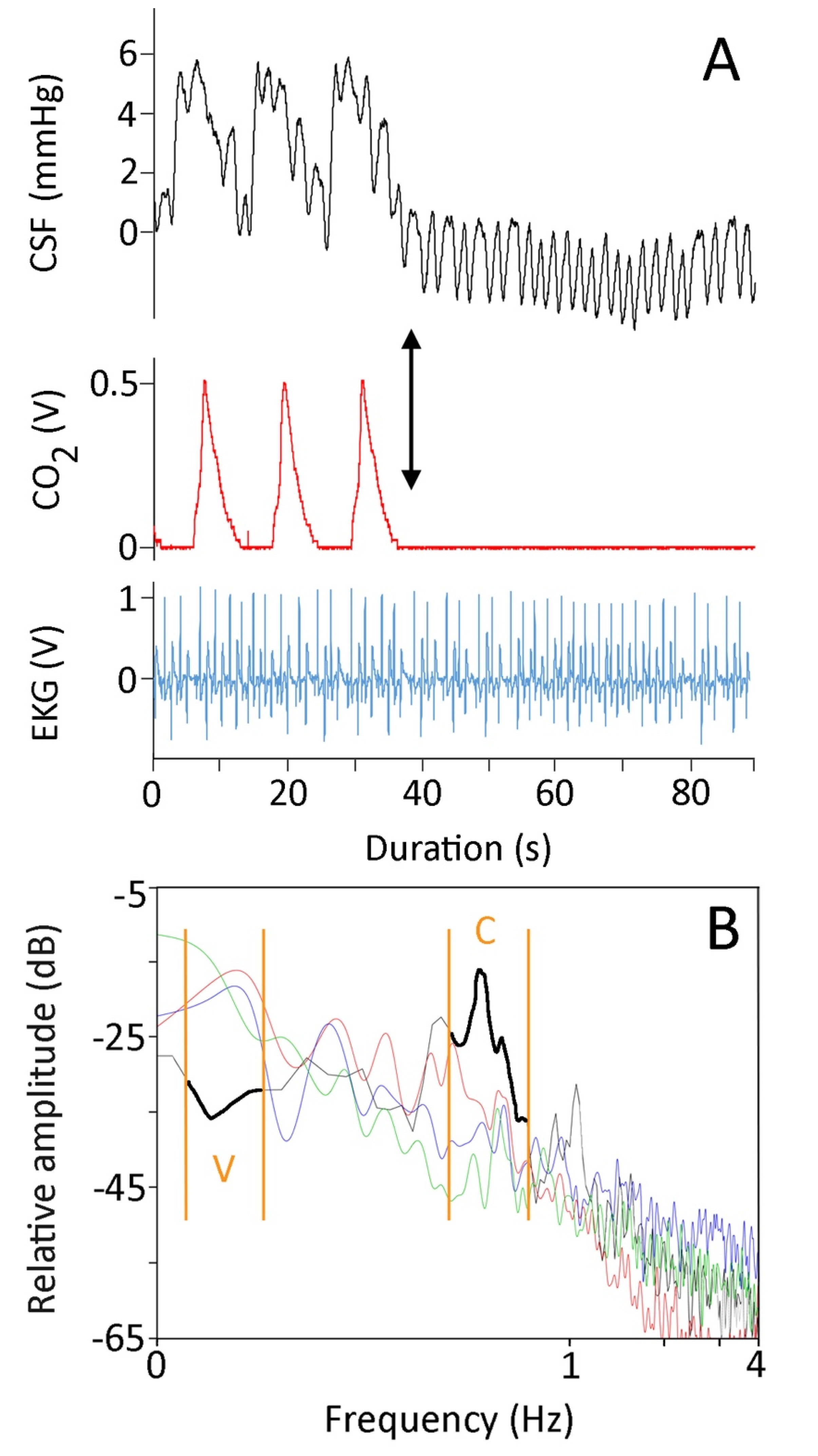
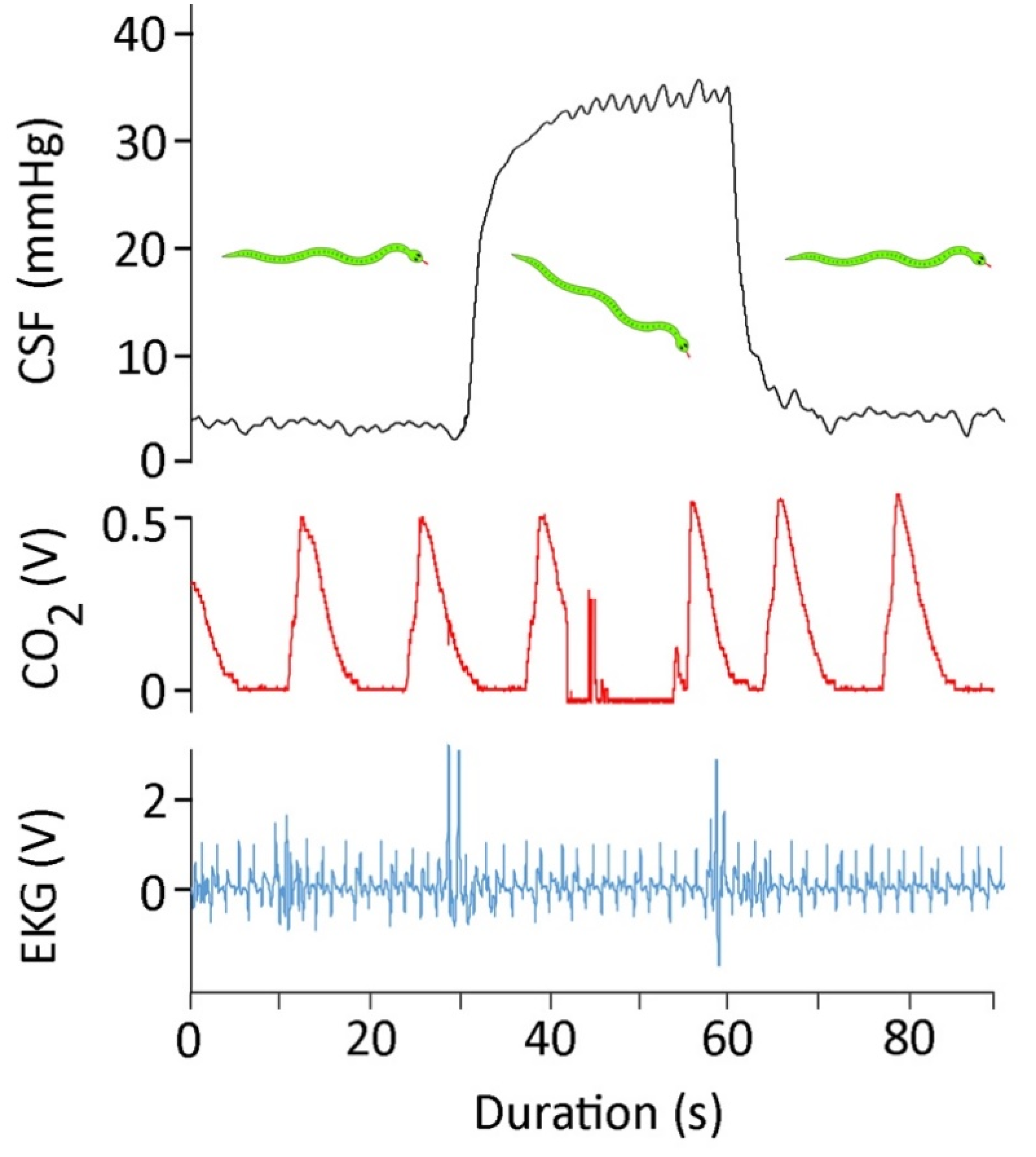

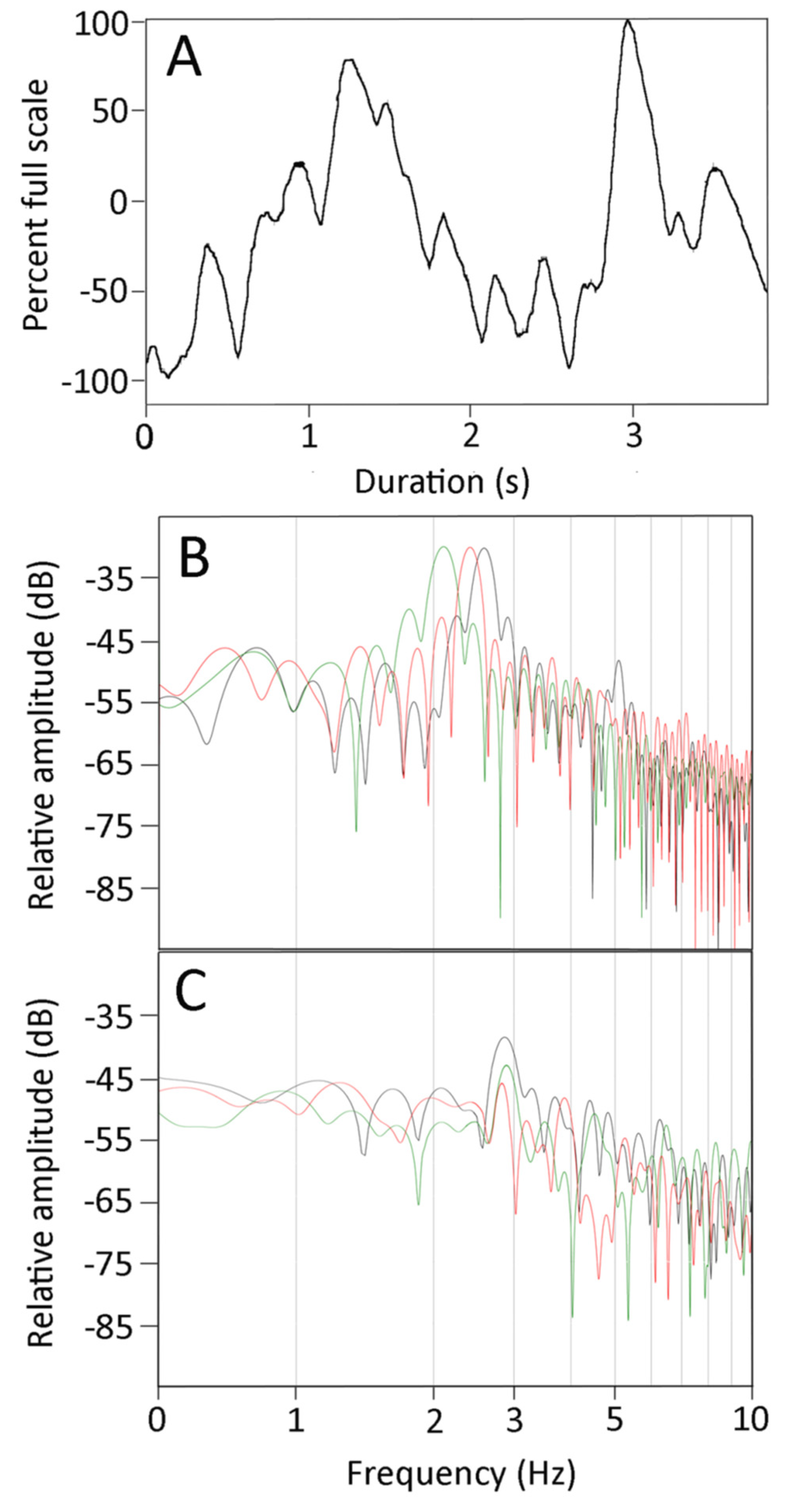

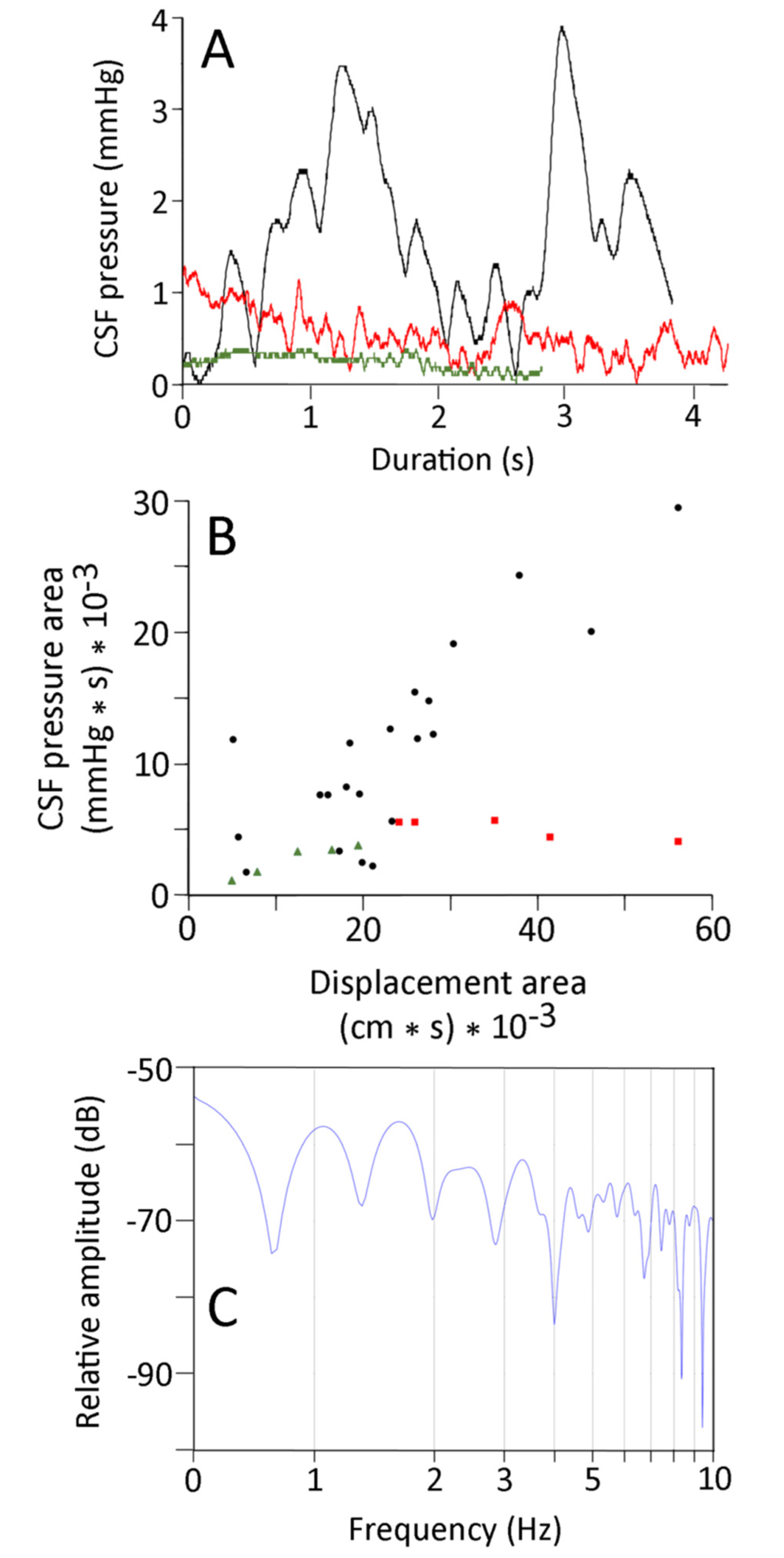
| Manual | Lateral | Concertina | |
|---|---|---|---|
| Oscillations | Undulation | Locomotion | |
| Number of undulations | 7.7 (0.6) | 2.0 (0.0) | 1.0 (0.0) |
| Propagation velocity | 116.9 (5.9) | 22.6 (7.9) | |
| Mean undulation frequency | 2.9 (0.1) | 0.6 (0.1) | |
| Mean displacement | 2.6 (0.1) | 5.4 (0.6) | 1.7 (0.7) |
| Max displacement | 6.9 (0.3) | 12.5 (0.9) | 4.1 (0.9) |
| Mean velocity | −0.1 (0.1) | 0.6 (1.2) | 0.2 (0.4) |
| Max velocity | 102.4 (6.0) | 77.2 (3.2) | 31.8 (2.0) |
Publisher’s Note: MDPI stays neutral with regard to jurisdictional claims in published maps and institutional affiliations. |
© 2021 by the authors. Licensee MDPI, Basel, Switzerland. This article is an open access article distributed under the terms and conditions of the Creative Commons Attribution (CC BY) license (https://creativecommons.org/licenses/by/4.0/).
Share and Cite
Young, B.A.; Greer, S.; Cramberg, M. Slithering CSF: Cerebrospinal Fluid Dynamics in the Stationary and Moving Viper Boa, Candoia aspera. Biology 2021, 10, 672. https://doi.org/10.3390/biology10070672
Young BA, Greer S, Cramberg M. Slithering CSF: Cerebrospinal Fluid Dynamics in the Stationary and Moving Viper Boa, Candoia aspera. Biology. 2021; 10(7):672. https://doi.org/10.3390/biology10070672
Chicago/Turabian StyleYoung, Bruce A., Skye Greer, and Michael Cramberg. 2021. "Slithering CSF: Cerebrospinal Fluid Dynamics in the Stationary and Moving Viper Boa, Candoia aspera" Biology 10, no. 7: 672. https://doi.org/10.3390/biology10070672
APA StyleYoung, B. A., Greer, S., & Cramberg, M. (2021). Slithering CSF: Cerebrospinal Fluid Dynamics in the Stationary and Moving Viper Boa, Candoia aspera. Biology, 10(7), 672. https://doi.org/10.3390/biology10070672






